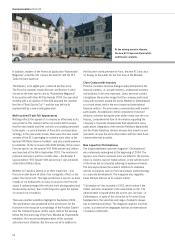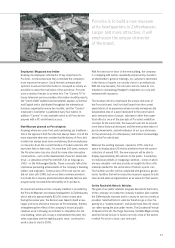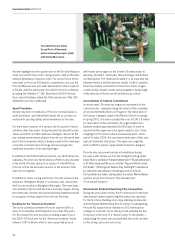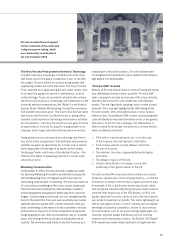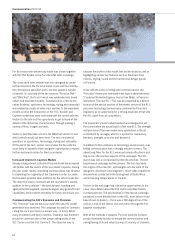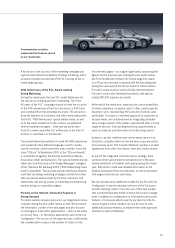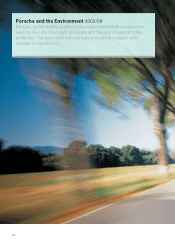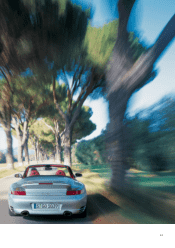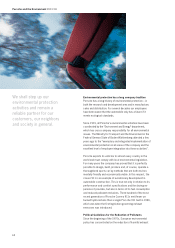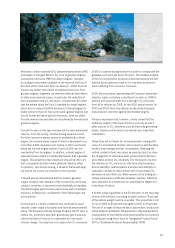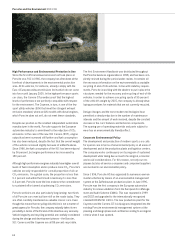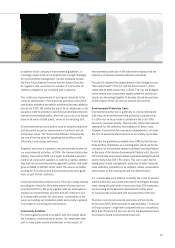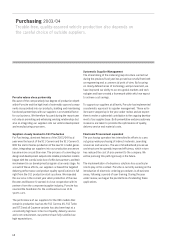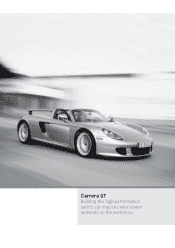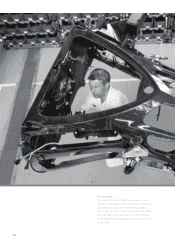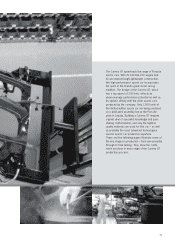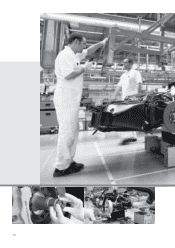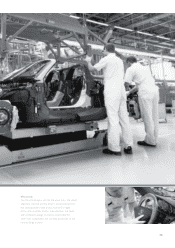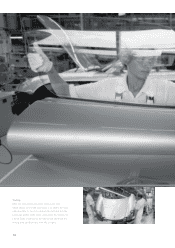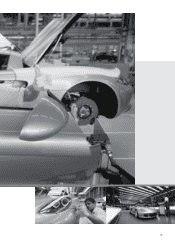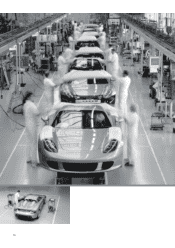Porsche 2003 Annual Report Download - page 70
Download and view the complete annual report
Please find page 70 of the 2003 Porsche annual report below. You can navigate through the pages in the report by either clicking on the pages listed below, or by using the keyword search tool below to find specific information within the annual report.
66
High Performance and Environmental Protection in One
Since the first official exhaust emission test took place at
Porsche on a 911 in 1966, the company has often been at the
forefront of developments in the environmental protection
area. All its vehicles, for instance, already comply with the
Euro 4 European exhaust emissions limits which do not come
into force until January 2005. In the high-performance sports
car class, the Carrera GT provides proof that the highest
levels of performance are perfectly compatible with respect
for the environment. The Cayenne, in turn, is one of the few
sport utility vehicles (SUV) that meet the stringent exhaust
emission standard, whereas SUV models with diesel engines,
which Porsche does not sell, do not meet these standards.
Despite our position as the smallest independent automobile
manufacturer in the world, Porsche supports the European
automotive industry’s commitment to the reduction of CO2
emissions. In the case of the new 911 Carrera (997), engine
output has been increased still further and fuel consumption
has also been reduced, despite the fact that the overall weight
of the vehicle increased slightly because of added features.
Since 1966, the fuel consumption of the 911 has been reduced
by 36 percent, but engine performance has increased by
150 percent.
Although high-performance engines naturally have higher overall
levels of fuel consumption and so produce more CO2, Porsche’s
vehicles are only responsible for a small proportion of all car
CO2emissions. On a global scale, the proportion is less than
0.1 percent and within the EU and in Germany it is less than
0.2 percent. Porsche none the less endorses the committment
to sustained effort aimed at optimizing CO2emissions.
Porsche vehicles are also particularly long-lasting: two thirds
of all Porsche cars ever built are still on the roads today. They
are often carefully maintained as valuable classic cars. Even
though this means that recycling old vehicles is not a matter of
great urgency for Porsche, the company naturally takes its res-
ponsibility in terms of the EU end-of-life directive very seriously.
Vehicle longevity and recycling potential are carefully considered
during the design and development phases – the Boxster,
911 Carrera and the Cayenne are all 85 percent recyclable.
The first Environment Handbook was distributed throughout
the Porsche business organization in 1998, and has been com-
pletely revised during the period under review. It contains all
the necessary information on the environmentally acceptable
recycling of end-of-life vehicles. In line with statutory require-
ments, Porsche is working with the dealers to put in place the
structures needed for the recovery and recycling of end-of-life
vehicles. In order to achieve a recycling quota of 95 percent
of the vehicle’s weight by 2015, the company is already deve-
loping procedures for materials that are not currently recycled.
Design changes and the most modern technologies have
permitted a steady reduction in the number of maintenance
intervals and the amount of work involved, despite the constant
increase in the cars’ features and technical components.
The sparing use of operating materials and parts subject to
wear has an environmentally friendly effect.
Corporate Environmental Policy
The development and production of modern sports cars calls
for special care in terms of environmental policy in all areas of
development and at the production plants and logistics centers.
The company works continuously on its program of sustained
development while taking due account of ecological, economic
and social considerations. For this reason, not only our em-
ployees but also all service companies and component suppliers
are involved in our environmental policy.
Since 1996, Porsche AG has organized its numerous environ-
mental activities by means of an environmental management
system at the Zuffenhausen production plant. In June 1996,
Porsche was the first company in the European automotive
industry to receive validation from the European Eco-Manage-
ment and Audit Scheme (EMAS). This was repeated in 1999
and 2002 and upgraded to the internationally recognized
standard DIN EN ISO 14001. The new production plant for the
Cayenne and the Carrera GT in Leipzig was integrated into the
existing Porsche environmental management system at the
planning and design phase and certified according to ecological
criteria when it was opened.
Porsche and the Environment 2003 ⁄ 04


